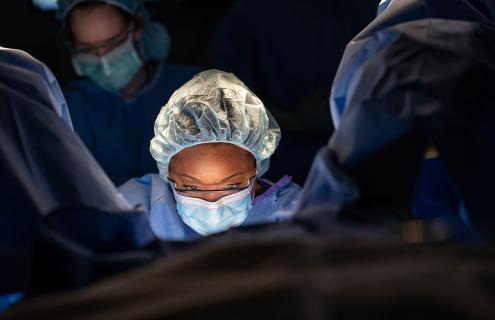
I enjoy being in the operating room and the entire atmosphere that it brings. Unfortunately, expertise in brachytherapy is becoming increasingly rare and I am one of very few fellowship-trained brachytherapists in the country.
Shauna M. McVorran, MDShauna M. McVorran, MD, is one of a handful of fellowship-trained brachytherapists in the United States. Having joined Dartmouth Cancer Center in 2022, patients in New England now have access to McVorran’s expertise.
In this Q&A, she outlines the unique care she provides and why she’s inspired by her patients every day.
What is brachytherapy? How do you explain this treatment to your patients?
McVorran: With brachytherapy, we place a radioactive source very close to or directly inside the area that we want to treat. This allows us to give high doses of radiation to the cancer while sparing the surrounding organs. We use a variety of applicators and templates that allow passage of the radioactive source. These come in 3 main forms:
- Interstitial applicators. This consists of needles (catheters) that are placed into the site of interest. Some examples include prostate or head and neck brachytherapy.
- Intracavity applicators. These take advantage of natural body cavities or cavities created by surgery to deliver the radiation close to the site of interest. Vaginal cuff brachytherapy using a vaginal cylinder or breast brachytherapy using a balloon or strut-based system are some common procedures of this type.
- Surface applicators. With these, the source is placed on the surface of the area to be treated using plaques or custom molds (e.g., episcleral or skin brachytherapy).
Which patients might benefit from this treatment?
McVorran: Brachytherapy is the standard-of-care for some cancers including gynecologic and prostate cancers as well as uveal (eye) melanomas. Standard-of-care means brachytherapy is the go-to treatment for those conditions.
There are many other diseases, however, where brachytherapy has an established use. These includes head and neck, skin, breast, gastrointestinal and lung cancers, and sarcomas. Particularly for head and neck cancer, brachytherapy is used for patients who have had multiple recurrences. We want to be conscious of those who have had previous rounds of radiation. Brachytherapy is useful in these cases because of its unique ability to spare normal tissue.
I admire [my patients'] strength and perseverance, and most importantly their hope for the future. Their spirit inspires me every day to do the best that I can for them.
Shauna M. McVorran, MD
Does anyone else in our region offer brachytherapy?
McVorran: There is a group in southern New Hampshire that does simple brachytherapy implants. Dartmouth Cancer Center Radiation Oncology is the only center in New Hampshire, however, that offers interstitial and other complicated implants.
We push the envelope to pursue excellence in brachytherapy. We plan to introduce new service lines to better serve the patients of New England.
What drew you to brachytherapy and what makes your work unique?
McVorran: I quite enjoy the procedural nature of brachytherapy! I enjoy being in the operating room and the entire atmosphere that it brings. Unfortunately, expertise in brachytherapy is becoming increasingly rare and I am one of very few fellowship-trained brachytherapists in the country.
Brachytherapy is very effective. It's also very labor and resource intensive and not well reimbursed. Therefore, fewer radiation oncologists are practicing this technique. The residents they teach are not gaining exposure either. As a field, we're trying to resolve that. Fostering mentorships and fellowships like the one that I completed is an important part of our process.
What is your source of inspiration?
McVorran: I am continuously inspired by my patients. I admire their strength and perseverance, and most importantly their hope for the future. Their spirit inspires me every day to do the best that I can for them.

About Shauna M. McVorran, MD
Meeting cancer patients and hearing their stories motivated me to become a radiation oncologist. I focus on their experience. A major part of my job is providing the information patients need to feel positive about their choices and the treatment process. My goals are to make their cancer care as smooth as possible while giving them an opportunity to live long, happy lives.